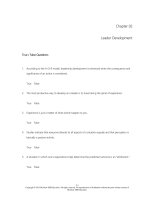Leadership enhancing the lessons of experience 8th by hughes curphy chap 09
Bạn đang xem bản rút gọn của tài liệu. Xem và tải ngay bản đầy đủ của tài liệu tại đây (578.72 KB, 31 trang )
Copyright © 2015 McGraw-Hill Education. All rights reserved. No reproduction or distribution without the prior written consent of McGraw-Hill Education.
9-1
Chapter
9
Motivation, Satisfaction, and
Performance
“Polls estimate that if companies could get 3.7
percent more work out of each employee, the
equivalent of 18 more minutes of work for each
eight-hour shift, the gross domestic product in the
U.S. would swell by $355 billion, twice the total
GDP of Greece.”
~The Gallup Organization
9-2
Introduction
• The ability to motivate others is a fundamental
leadership skill and has strong connections to
building cohesive, goal-oriented teams and
getting results through others.
• Variation in work output varies significantly
across leaders and followers.
• Creating highly motivated and satisfied
followers depends mostly on understanding
others.
9-3
Defining - Motivation, Satisfaction,
and Performance
• Motivation is anything that provides direction,
intensity, and persistence to behavior.
– Not observable; must be inferred from behavior.
• Performance concerns behaviors directed
toward the firm’s mission/goals or the products
or services resulting from those behaviors.
– Differs from effectiveness i.e., making judgments
about the adequacy of behavior based on criteria.
• Job satisfaction is how much one likes a
specific kind of job or work activity.
– Satisfied workers engage in organizational
citizenship behaviors.
9-4
Relationships among Leadership,
Job Satisfaction, and Performance
9-5
Understanding and Influencing
Follower Motivation
• Motivational theories are useful in certain
situations but not as applicable in others.
• Leaders who know about different motivational
theories are more likely to choose the right
theory for a particular follower and situation.
– Choosing the best theory may result in higherperforming and more satisfied employees.
• Most performance problems can be attributed
to unclear expectations, skill deficits, resource/
equipment shortages, or a lack of motivation.
• Leaders have the most difficulty recognizing
and correcting motivation problems.
9-6
Five Motivational Approaches
Table 9.1 Five Motivational Approaches
9-7
Maslow’s Hierarchy of Needs
• According to Maslow, people are motivated by 5
basic types of needs (hierarchy of needs).
– Needs are internal states of tension or arousal, or
uncomfortable states of deficiency.
• When needs are not being met, people engage
in certain behaviors to satisfy them.
• To motivate employees to work harder, leaders
must determine where their followers are on the
needs hierarchy and ensure that all lower-order
needs are satisfied before appealing to their
higher-order needs.
9-8
Maslow’s Hierarchy of Needs
(continued)
9-9
Maslow’s Hierarchy of Needs
(continued)
• Maslow’s theory does not make specific
predictions about what an individual will do to
satisfy a particular need.
• The lack of specificity and predictive power
limits the practical applicability of Maslow’s
theory in real-life settings.
• However, awareness of the general nature of
various sorts of basic human needs seems
fundamentally useful to leaders.
• Leaders need to address some basic,
fundamental areas before their attempts to get
followers to expend more effort on work-related
behaviors will be successful.
9-10
Achievement Orientation
• Atkinson proposed that a person’s tendency to
exert effort toward task accomplishment depends
partly on the strength of his/her motivation to
achieve success (i.e., achievement orientation).
• McClelland said that individuals with a strong
need for achievement strive to accomplish
socially acceptable endeavors and activities.
• Achievement orientation is a component of the
Five Factor Model or OCEAN model of
personality dimension of conscientiousness.
• Achievement orientation is often a key success
factor for people who advance to the highest
levels of organizations.
9-11
Goal Setting
• From the leader’s perspective, goal setting
involves setting clear performance targets and
helping followers create systematic plans to
achieve them.
• According to Locke and Latham, goals are the
most powerful determinants of task behaviors.
• Goals direct attention, mobilize effort, help people
develop strategies for achievement, and help
people continue exerting effort until goals are
reached. This leads, in turn, to even higher goals.
9-12
Goal Setting (continued)
• Locke and Latham’s research identified several
common aspects of goal setting.
1. Goals that were both specific and difficult resulted in
consistently higher effort and performance when
contrasted to “do your best” goals.
2. Goal commitment is critical. Goals set either by leaders
unilaterally or through participation with followers can
lead to necessary levels of commitment.
3. Followers exerted the greatest effort when goals were
accompanied by feedback; followers getting goals or
feedback alone generally exerted less effort.
9-13
Goal Setting (continued)
3. A leader’s implicit and explicit expectations about
goal accomplishment can affect the performance
of followers and teams.
A. The Pygmalion effect occurs when leaders express
high expectations for followers. These expectations
alone lead to higher-performing followers and teams.
B. The Golem Effect occurs when leaders have little
faith in their followers’ ability to accomplish a goal.
These expectations result in a self-fulfilling prophecy
and low performance.
4. Leaders wanting to improve individual/team
performance should set high but achievable
goals and express confidence in their followers.
9-14
The Operant Approach
• The operant approach utilizes the following
components to change the direction, intensity,
or persistence of behavior.
1. Reward
2. Punishment
3. Contingent rewards and punishments
4. Non-contingent rewards and punishments
5. Extinction
9-15
The Operant Approach (continued)
• Using operant principles to improve followers’
motivation and performance requires several
steps.
1. Clearly specify what behaviors are important.
2. Determine if those behaviors are currently being
punished, rewarded, or ignored.
3. Find out what followers find rewarding and punishing.
4. Be wary of creating perceptions of inequity when
administering individually tailored rewards.
5. Do not limit oneself to administering organizationally
sanctioned rewards and punishments.
6. Administer rewards and punishments in a contingent
manner whenever possible.
9-16
Empowerment
• Empowerment has two key components:
1. Leaders delegate leadership and decision making
down to the lowest level possible.
2. Leaders equip followers with the resources, skills,
and knowledge necessary to make good decisions.
– Macro psychological components:
1.
2.
3.
Motivation
Learning
Stress
– Micro psychological components:
1.
2.
3.
4.
Self-determination
Meaning
Competence
Influence
9-17
Empowerment (continued)
• Many leaders assume it is easier to change an
individual than it is to change the situation, but
this is often not the case.
• Leaders can often see positive changes in
followers’ motivation levels by restructuring work
processes and procedures.
– This can increase their latitude to make decisions and
add more meaning to work.
• Leaders can help followers work through initial
resistance to new processes and procedures by
showing support, providing training and
coaching on new skills, and capitalizing on
opportunities to reward progress.
9-18
Motivation Summary
• A leader’s actions can and do affect followers’
motivation levels.
• Leaders should be flexible in the types of
interventions they use to motivate followers,
which requires familiarity with the pros and cons
of various motivational theories.
• Leadership practitioners should not overlook the
interplay between emotions and motivation.
• Success is more likely when leaders are able to
address and capitalize on emotions when
introducing change.
9-19
Understanding and Influencing
Follower Satisfaction
• Satisfied workers are more likely to continue
working for an organization and engage in
organizational citizenship behaviors.
• Dissatisfied workers are more likely to be
adversarial in their relations with leadership and
engage in diverse counterproductive behaviors.
• Employee turnover has the most immediate
impact on leadership practitioners.
1. Functional turnover is healthy for an organization,
such as when followers retire, do not fit into the
organization, or are substandard workers.
2. Dysfunctional turnover is unhealthy and occurs
when an organization’s best and brightest become
dissatisfied and leave.
9-20
Follower Satisfaction
Table 9.2 Why People Leave or Stay with Organizations
9-21
Global, Facet, and Life Satisfaction
• Three types of items are typically found on job
satisfaction surveys.
1. Global satisfaction is the overall degree that
employees are satisfied with their organization and
their job.
2. Facet satisfaction is the degree that employees
are satisfied with different aspects of work (pay,
benefits, promotion policies, working hours and
conditions).
3. Life satisfaction concerns a person’s attitudes
about life in general.
9-22
Global, Facet, and Life Satisfaction
(continued)
• Surveys have important findings for leaders.
– People generally like their occupations but may not like
the pay, benefits, or their boss.
– People with longer tenure or in higher positions tend to
have higher global and facet satisfaction ratings than
those newer to or lower in the organization (i.e.
hierarchy effect).
– People who are happier with their jobs tend to have
higher life satisfaction ratings.
• Survey results are most useful when compared
with results from a reference group, such as the
organization’s past results or ratings from similar
organizations.
9-23
Global, Facet, and Life Satisfaction
Table 9.3: Typical Items on a Satisfaction Questionnaire
9-24
Eight Theories of Satisfaction
9-25









